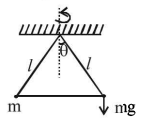Question
A bob of mass $$m$$ attached to an inextensible string of length $$l$$ is suspended from a vertical support. The bob rotates in a horizontal circle with an angular speed $$\omega \,rad/s$$ about the vertical. About the point of suspension:
A.
angular momentum is conserved.
B.
angular momentum changes in magnitude but not in direction.
C.
angular momentum changes in direction but not in magnitude.
D.
angular momentum changes both in direction and magnitude.
Answer :
angular momentum changes in direction but not in magnitude.
Solution :
Torque working on the bob of mass m is, $$\tau = mg \times \ell \sin \theta .$$ (Direction parallel to plane of rotation of particle)

As $$\tau $$ is perpendicular to $$\vec L,$$ direction of $$L$$ changes but magnitude remains same.
Torque working on the bob of mass m is, $$\tau = mg \times \ell \sin \theta .$$ (Direction parallel to plane of rotation of particle)

As $$\tau $$ is perpendicular to $$\vec L,$$ direction of $$L$$ changes but magnitude remains same.
